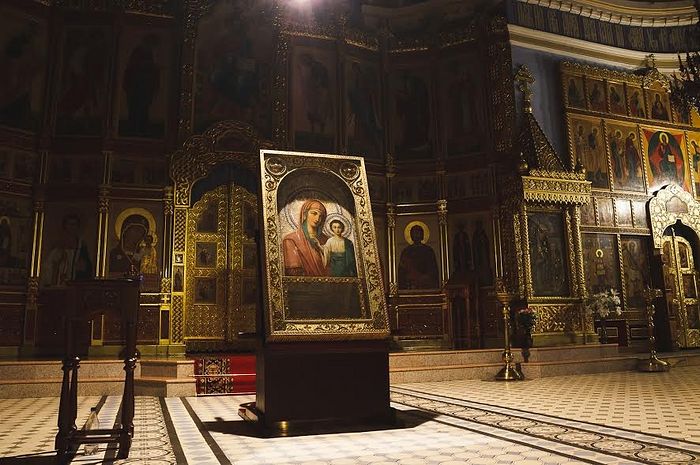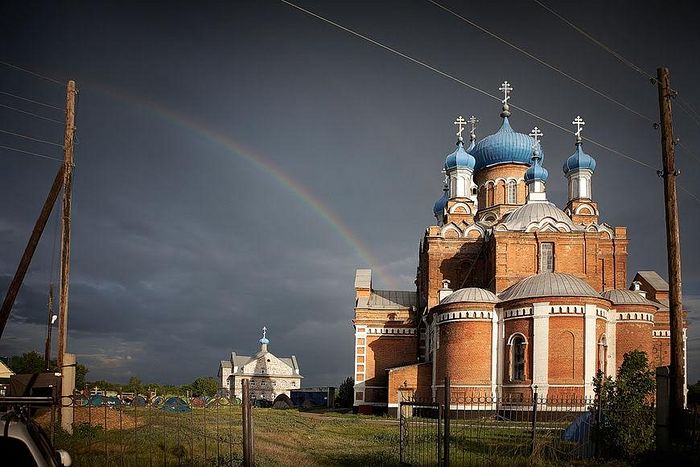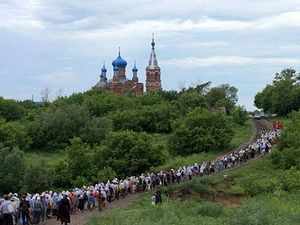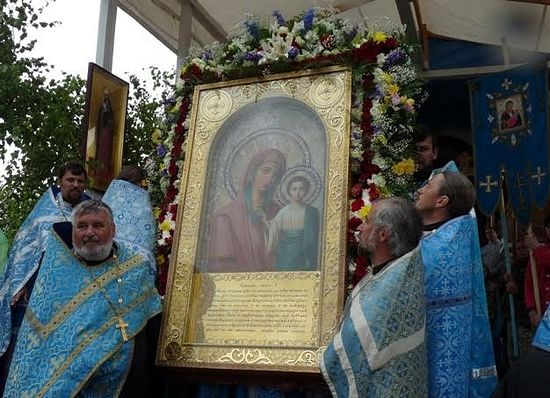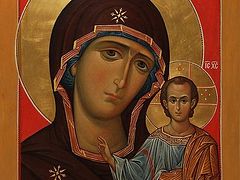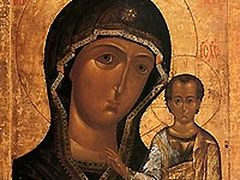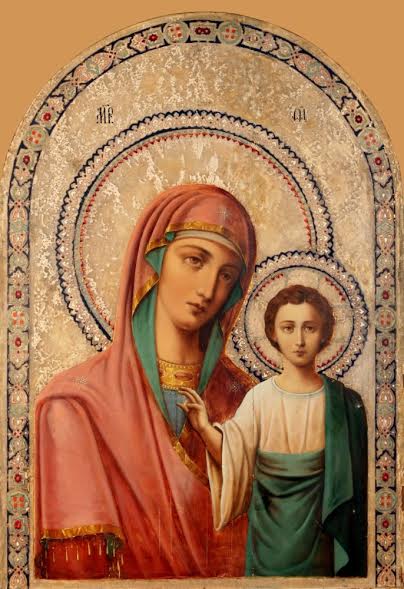
The revival of Orthodoxy in Siberia is somewhat belated in comparison with how it happened in central Russia. The reason for this is that the Siberian lands were assimilated rather late and did not know the ancient piety of medieval Rus’, with few monasteries, and few renowned ascetics and saints. The Siberian lands are famous for their vast, fertile lands, brave pioneers and experienced people who resettled there searching for a better life, and sometimes trying to hide from the authorities. Many Siberian saints labored in the mission field, such as the hierarchs Sts. Makary, Sophrony, and Innokenty of Irkutsk, and the ascetics and fools-for-Christ for which Verkhoturye, in the middle of the Ural Mountains, is famous. The spiritual life was mainly focused in large cities—Tomsk, Tobolsk, and Irkutsk, which to this day are like great and populous oases amidst the vast expanse of the Siberian land. Believers in our time have often had to not only revive, but begin their spiritual lives without footing on tradition or history. The tiny village of Korobeinikovo in the Biysk region became the center of the revival and recreation of Church life in Siberia, a symbol of the unity of men with heaven, thanks to the miraculous appearance there of the wonderworking icon of the Kazan Mother of God. In our days, thousands of believers come to venerate the holy image and receive abundant healing, comfort, and correction.
However, no one knew about this icon before the revolution, and only at the end of the Soviet era was it revealed to Orthodox Christians. The history of the icon is closely connected with the history of the new martyrs and confessors and righteous ones of the Siberian land in the twentieth century. The icon comes from the church of the Kazan Mother of God in the Biysk village of Korobeinikovo, and before the ravaging of churches in 1936-1938 it was the patronal icon, occupying a central place in the church.
Before the 1917 revolution, Korobeinikovo was known as Ust-Kamensky Istok, but the post office was obliged to change the name, chosen in memory of the peddlers and merchants who delivered goods through the Siberian lands and even traded with China. Every year in the village there would be large markets, thronged with thousands of people, such that the main work was not farming or beekeeping, but precisely trade. The village was large and prosperous; in 1904 the adult population was around 5,500. Considering that nearly every family in Russia of that time had many children, we can confidently multiply the number of residents many times. In modern times a few more than a thousand people live there, which clearly demonstrates the consequences of the October Revolution and the subsequent bloody events of Russian history.
The magnificent and spacious single-altar stone church in honor of the Kazan Mother of God was built and painted in 1910 by the Biysk workshop of A. A. Borzenkova. An elevated place was chosen for the church, such that, praying in the church and turning towards the exit, you could see only the heavenly vault, as if the church was floating in the clouds. The temple was truly magnificent. It could be called a masterpiece of that time which is known as the Silver Age of Russian culture.
Subtlety, lyricism, the intrinsic strength and credibility of the icon, and the pure colors, impart to the icon an especial beauty and festive solemnity. The icon of the Mother of God was painted in the style of the Athonite school, which aspired to show the transfiguration of human nature in a picturesque style. The icon was quite large, such that several people had to carry it in processions. Already before the revolution the tradition of processing with the icon in the summer was born in Korobeinikovo, as it had been observed that rain would fall after praying before the holy image in times of drought.
In 1936 the last priest of the church of the Kazan Mother of God, Fr. Roman, was arrested, and in 1938 the church was destroyed and converted into a granary. Believers were able to save some of the most revered icons, but the atheists made an example of throwing the patronal icon of the Mother of God to the ground, cattle and people walking on it. Then the icon, face turned upwards, was used in place of floor boards in the church-turned-granary, and those entering trampled upon it with their feet. Believers bewailed the desecrated holy object, but were afraid to approach it as the atheists vigilantly ensured that the icon remained in the ground to be profaned daily.
The icon was saved by two weak and squalid women, residents of the village of Korobeinikovo, afterwards revered as righteous ones, Olga Gavrilovna Peregudova and Domnika Phateevna Kapustina. Little information has been preserved about these righteous strugglers. Olga Peregudova was known amongst the people as “Dark Olga” because she went blind in her childhood after suffering smallpox, remaining the rest of her life in prayer, as her older sisters had taught her. Olga prayed incessantly, and her spiritual qualities of modesty, simplicity and gentleness evoked the respect of the villagers. Many believers went to her, beseeching her prayers, and related to her as to a righteous person.
Dark Olga heard the voice of the Mother of God one night in a dream, commanding her to take her image that people were trampling. Olga implored the Mother of God, saying that she was weak and blind and unable to fulfill the command. Having woken, she prayed for a long time, then summoned her niece and told her about the order. The girl answered with fright that the church is guarded by a watchman. The dream repeated itself the following night, but the Mother of God commanded her to tell the instructions not to her relatives, but to others. Olga again continued in prayer until her perky and lively neighbor came to visit her. Hearing of the command of the Mother of God, she joyfully agreed to go retrieve the icon. The women sewed a large sack and headed for the church. There they discovered that the watchman was away for a while and managed to take the icon, hiding it in the sack they had brought. Word soon spread around the village that the icon had been taken from the church, but by the prayers of Olga, no investigation followed.
Bringing the icon home, Olga heard the command: “Take me in your left hand, and wash me with your right.” The women brought water and Olga washed the icon, after which it became clear that the top layer of paint had been worn out by feet, and crumbled, and the faces of the Mother of God and the Christ Child were severely damaged and barely discernible, and in the middle of the icon there appeared a crack as thick as a finger. Only the eyes of the Mother of God and the Divine Child remained undamaged. Seeing this, the women wept and prayed. From the icon came a voice that all present heard: “All, all have sinned!” and from the eyes of the Mother of God flowed tears.
From that time the faithful residents of Korobeinikovo and the surrounding areas began to come to Olga’s house to pray before the icon. Not far from Korobeinikovo is the village of Nizhneozernoe where the eldress Domna (Domnika) Kapustina lived, who would send people to Olga, the keeper of the icon, to pray. Nuns of the ruined Tikhvin Monastery in Biysk lived with Eldress Domna. She was unable to walk and in need of constant care, which the nuns of the ruined monastery provided. Olga and Domna were in constant prayerful communion, and with the help of others Olga often went to Domna’s house for common prayer.
A great number of people came to Domna for advice, teaching, and healing. In 1929 she was subject to repression, and the pilgrims Pavel Pilyugin, Sergei Pomazkov and the chanter of the Nizhneozernoe church, Taras Belkin, who had cared for her, were brought to up on criminal charges. In the minutes of their conviction it is registered that they “hauled Domna through the churches and villages to excite the superstitious people, creating an aura of sanctity around her.”
Hieromartyr Nikita (Pribytkov), the bishop of Biysk, canonized in 2001 in Tula, was arrested in a criminal case against the Church community associated with the name of the eldress Domna. Domna was repeatedly subjected to arrest, and in local papers she was subjected to ridicule. Thus, on February 4, 1931 the regional gazette “The Collective Banner” published the memo “Church agitators brought to justice,” which, in particular, said: “Last year Domna and her minions underwent a show trial for counter-revolutionary agitation. Her henchmen were convicted, but Domna, being an invalid, went unpunished. It was necessary to immediately end Domna’s counter-revolutionary agitation and to condemn her together with the Church elder.” In the interrogation reports Domna prudently and guardedly answered the investigators’ questions: “Yes, people come to me, consider me a saint, but I don’t consider myself holy at all.” Despite pressure, she didn’t give any statement against the faithful, priests, or the nuns. Domna reposed in 1979 after being attacked by thieves, who, having broken into her cell, threw her to the floor in search of some non-existent treasure.
The righteous and prayerful Domna and Olga prayed together before the icon of the Mother of God, which gradually became the center of the persecuted Christianity in those places. On the feast of the Kazan Mother of God and on Sundays many would come to pray before the icon and would stay in the home of Olga and Eldress Domna. The protectors of the icon served those coming to them and healing often came by the prayers of these righteous women. They preserved the news of the women’s clairvoyance and of the gifts of discernment and consolation which Olga and Eldress Domna possessed. Olga would pray six thousand Jesus Prayers on her prayer rope before the icon. She fervently prayed before the icon for clarity concerning the needs of those who constantly came to her with various requests and needs.
In 1960, Olga and her sister moved to Barnaul, taking the Kazan Icon there with them. Pilgrimage to the icon did not stop at the new place. After her sister’s death, she, being already a very frail old woman, settled into the home of Barbara and Theodore Shilkin, telling them she would live with them for eleven years. Having moved to the new place, she pointed out where to place the icon and there continued her prayerful intercession before God. In the new home the eldress remained simple and friendly in dealing with people. On Pascha 1972, in the night of April 8-9, the Kazan Icon of the Mother of God completely renewed itself—the surface became smooth, all traces of the crack disappeared, and the paint shone with pure, deep colors. The owners of the home, Barbara and Theodore were afraid to show the icon, refusing to allow unfamiliar people to visit.
In 1977 Olga reposed and the icon remained in the Shilkin’s home, so the half-century podvig of unceasing prayer before the holy icon ceased. In 1992, Theodore, being left a widower and already quite feeble, decided to transfer the icon to the church, but Galina Lyubitskaya (Schemanun Evlogia + 1996) had received the icon into her home for a while. The flood of believers coming to venerate the image of the Mother of God did not dry up, such that it was clear that the icon had to be given to the church, that veneration of the icon could spread even further. All that remained was to find a worthy place. Galina learned that in the village of Korobeinikovo they had begun to rebuild the church and decided to transfer the miraculous image back to its home.
The icon of the Mother of God was returned to its home church on September 8, the day of the Meeting of the Vladimir Icon of the Mother of God. The protector of the icon, Dark Olga, reposed on that day in 1977. A large procession from the city of Barnaul moved throughout the lands of Altai, nearly 500 kilometers to the village of Korobeinikovo. This was the first procession in honor of the Korobeinikovo Kazan Icon of the Mother of God, which began the annual tradition of a week-long, all-Siberian procession to the village of Korobeinikovo. Thus, finally, the story of the icon’s wanderings, once desecrated but saved by righteous believers and miraculously renewed, came to an end.
On July 22, 1994 it was decide to convert the parish church into the men’s Korobeinikovo Kazan Monastery, the main shrine of which became the miraculous icon of the Kazan Mother of God. By the blessing of His Holiness Patriarch Alexei II of Moscow and All Russia, the specific feast day of the Korobeinikovo Kazan Icon of the Mother of God was established as the first Sunday in July. On August 8, 2005, the icon was included in the list of sacred objects of the Russian Orthodox Church for Church-wide veneration.
In our time, the tradition of the great procession, which begins a week before the feastday of the Korobeinikovo icon, is becoming more widely-known. Believers prayerfully process throughout the Siberian lands with icon and banners, sleep in fields and villages under the starry sky, and process into the village of Korobeinikovo, where they meet thousands more believers who arrive from various cities of Siberia and central Russia. Festal services continue all evening, night, and day until lunchtime. Thousands of believers, whom the church cannot accommodate, confess and commune under the starry sky. After finishing the night Liturgy, early in the morning another altar is brought out to serve the second Liturgy at the night’s end.
An annual street fair was revived on the day of the Korobeinikovo icon and the village gradually revived, the monastery becoming the heart of the village. Innumerable healings and miracles before the Korobeinikovo icon have entered its chronicle, where they record only reliable cases which can be confirmed by witnesses. It is worth noting one significant fact. Before the revolution, the troparion to the Kazan Mother of God was written at the bottom of the icon. On the Paschal night when the entire image renewed itself, the letters of the troparion did not appear, leaving only gold threads on a white background. Later a new troparion and kontakion were written specifically for the Korobeinikovo icon, which are now used in the Divine services.
Troparion to the Kozobeinikovo Kazan Mother of God, Tone 4
As the dawn of the world’s never-setting Sun of Righteousness/so shoneth thy icon, O Mother of God,/appearing within the lands of Altai./All the church of Korobeinikovo so wast illuminated,/the darkness of atheism in our land dispersing/and the faithful being fortified in Orthodoxy./Now we pray to thee, O our fervent intercessor,//may thine icon be our protection from the wiles of enemies and the pledge of the salvation of our souls.

